Creating high-quality, adaptable bedroom decor for girls requires strategic planning, particularly for homeowners who prioritize longevity over fleeting trends. Many parents assume that a child’s room requires a costly, complete renovation to match every new developmental stage. This misconception often leads to the emotional difficulty of painting over nursery pastels or packing away childhood whimsy.
However, this transition involves more than just furniture; it marks the moment a girl claims “intimate authority” over her environment. The shift from a parent-curated space to one defined by her own choices is a necessary step in fostering independence.
Creating this adaptable sanctuary requires a “grow-with-her” foundation rather than a temporary theme. By investing in adult-sized, neutral core pieces—like a classic bed frame or dresser—you establish a canvas that withstands passing trends. This approach minimizes the need for major overhauls and allows the joy of design to flourish through easily changeable accessories. A growing girl can then exercise her creativity through bold bedding, removable wall murals, or a curated gallery wall, instantly updating the room’s energy without compromising the room’s structural longevity.
This guide outlines how to balance the structural needs of a functional retreat with the emotional nuances of growing up. We explore strategies for integrating smart storage solutions that transition a cluttered playroom into an organized study area, helping you build a flexible space that honors her past while providing the freedom to define her future.
Phase 1: The Foundation – Creating a Timeless Canvas
Begin by establishing a neutral base color palette to ensure the room remains adaptable. Paint walls in soft white, warm gray, or a classic monochrome scheme to create a flexible, airy backdrop. This foundation guarantees the space remains stylish and age-appropriate for years, regardless of current fads. By avoiding theme-specific wall colors now, you make future updates as simple as swapping out accessories rather than committing to labor-intensive repainting projects.
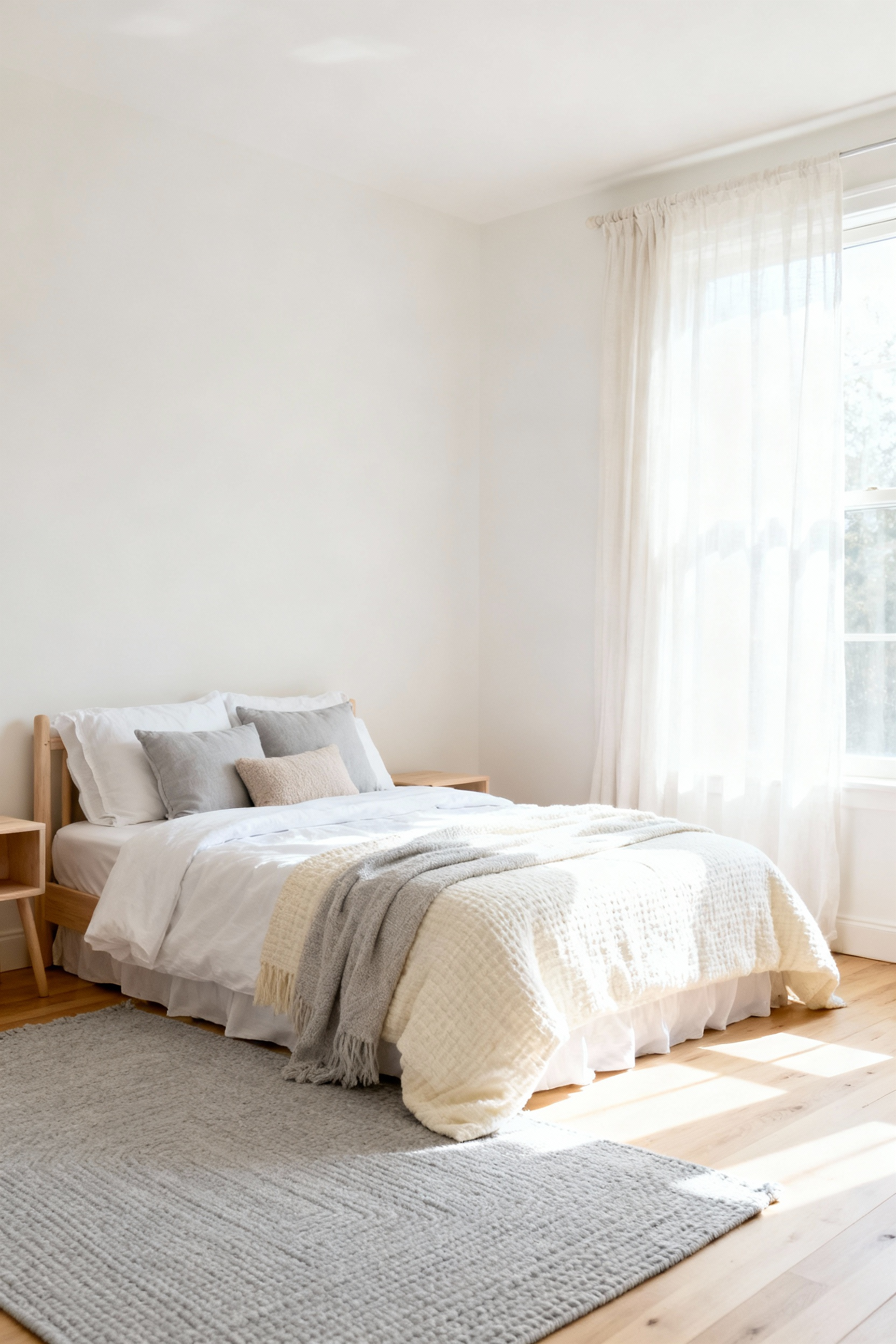
Invest your budget in high-quality, adult-sized furniture with classic lines. Choose a full-sized bed frame, dresser, and nightstand that can transition seamlessly from a young child’s room into a teen space or even a guest room later. Focusing on longevity saves significant time and money on major replacements down the road.
Complement these pieces with smart, non-juvenile storage solutions like woven baskets, bench seating with hidden compartments, or closed-door dressers. These elements keep clutter organized while ensuring the hard goods in the room never feel childish. Reserve specific themes and vibrant personality for easy-to-change accents. Introduce favorites, such as specific characters or colors like pink and lavender, strictly through replaceable items. Utilizing bedding, curtains, rugs, lamps, and artwork to carry the theme allows for quick, budget-friendly refreshes as a girl’s tastes evolve.
1. The ‘Blank Canvas’ Furniture Strategy: Investing in Neutral Bones
Establish a versatile foundation by investing in “bones” that stand the test of time. Select large, high-cost furniture pieces—such as the bed frame, dresser, and desk—in neutral shades like white, light wood, soft gray, or ivory. This approach prevents the need to replace expensive items as tastes evolve from childhood into adolescence. Additionally, lighter neutral colors on these substantial pieces reflect natural light, maximizing brightness and making smaller bedrooms feel open and expansive.

A neutral base creates a serene atmosphere conducive to sleep, but it also serves as a practical stage for creativity. Keep the permanent fixtures subtle to allow for easy, low-cost updates. You can completely alter the room’s style—shifting from a whimsical princess theme to a relaxed bohemian vibe—without lifting a heavy piece of furniture. This strategy provides maximum flexibility with minimum effort.
Layer personality onto this blank canvas through easily swappable elements. Introduce specific colors, patterns, and trends through accessories rather than structural investments. Focus on these items to express current interests:
- Textiles: Swap out bedding, throw pillows, and curtains to introduce themes like pinks, lavenders, or specific patterns.
- Decor: Use wall art, accent rugs, and lamps to add character.
- Accent Furniture: Incorporate trends through smaller, affordable pieces like a statement bean bag or a painted nightstand.
2. Modular Storage Systems That Evolve from Toys to Textbooks
Invest in neutral, modular base units to establish a foundation that outlasts passing trends. Select core pieces, such as cube shelving or wall systems, in timeless finishes like white, gray, or natural wood. These neutral tones act as a canvas, allowing functionality to take precedence over changing color palettes.
Prioritize tall units with adjustable shelving to maximize vertical space. This specific feature provides the flexibility to house oversized plush toys during the toddler years and reconfigure shelf heights later to accommodate standard-sized binders and academic textbooks.

Utilize interchangeable inserts to manage the transition from a playroom to a structured bedroom. Start by filling open cubbies with patterned fabric bins or baskets. These inserts effectively contain toy clutter while introducing color and texture as a design element. As the child matures, simply remove the bins to reveal open shelving suitable for displaying collectibles, framed photos, or books. This method allows you to update the room’s aesthetic instantly without purchasing new furniture.
Plan for the teenage years by selecting systems designed to integrate workspace components. Look for modular collections that allow you to seamlessly attach a desk, file drawers, or enclosed cabinets to the main shelving unit. This capability transforms a basic storage wall into a dedicated study center. By swapping toy bins for drawers and connecting a work surface, you create a sophisticated environment that supports high school coursework while maintaining a cohesive look.
3. Timeless Flooring Anchored by Adaptable Layered Rugs
Invest in a durable, timeless foundation before considering decor. Hard surfaces like engineered wood, luxury vinyl plank (LVP), or quality laminate offer the best long-term value because they withstand spills and heavy wear at every age. This permanent base serves as a neutral backdrop, allowing you to alter the room’s aesthetic without the hassle or expense of replacing wall-to-wall carpeting. A hard surface remains low-maintenance and easy to clean, ensuring the room functions well from the toddler years through the teenage phase.
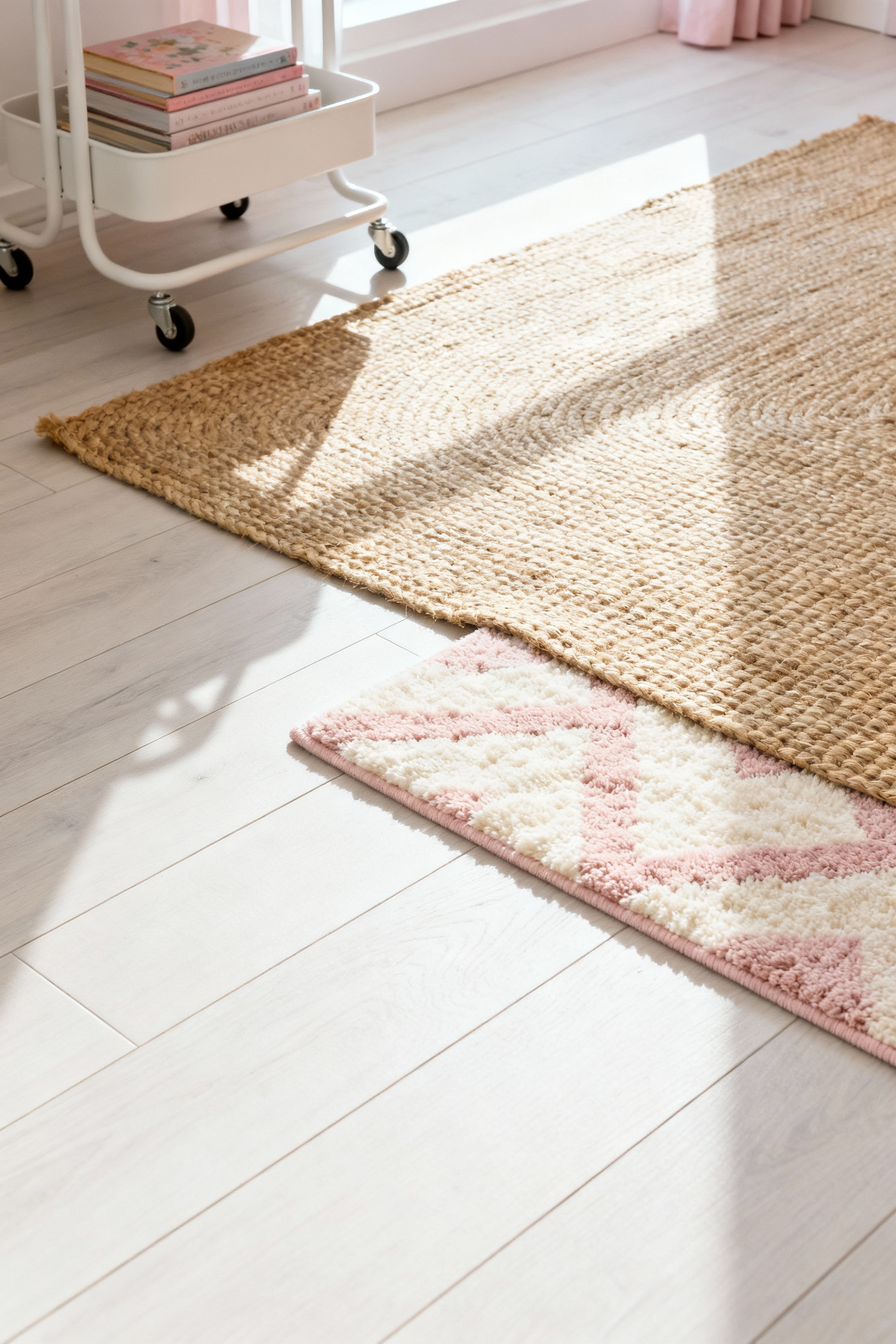
Create comfort and style through strategic rug layering. Begin with a large, neutral, low-pile foundation rug that extends under the main furniture to define the space. Materials like jute or simple geometric patterns work best here to set a cohesive tone. On top of this base, layer a smaller, trend-driven accent rug. This top layer introduces color and texture, such as a plush high-pile rug for a bedside reading nook. This method allows you to instantly transform the room’s theme by simply swapping the top rug.
Prioritize safety and acoustics in this layered setup. Always place high-quality, non-slip rug pads under every area rug on hard flooring. These pads are critical for preventing slips and falls, particularly in active play zones. Beyond safety, rug pads add necessary cushioning and sound absorption, creating a quieter and more comfortable environment. By combining a permanent hard floor with adaptable soft textiles, you build a room that evolves effortlessly with the child.
Phase 2: Injecting Personality – The Intermediate Layer
Once the structural foundation is complete, you must establish the room’s character through the intermediate layer. This phase moves beyond basic utility and introduces expressive elements that define the style. Start with an impactful wall treatment to anchor the space. Installing removable wallpaper, a large tapestry, or architectural details like beadboard adds necessary texture without requiring permanent construction. This step instantly transforms the atmosphere and serves as the primary backdrop for the girl’s personality.
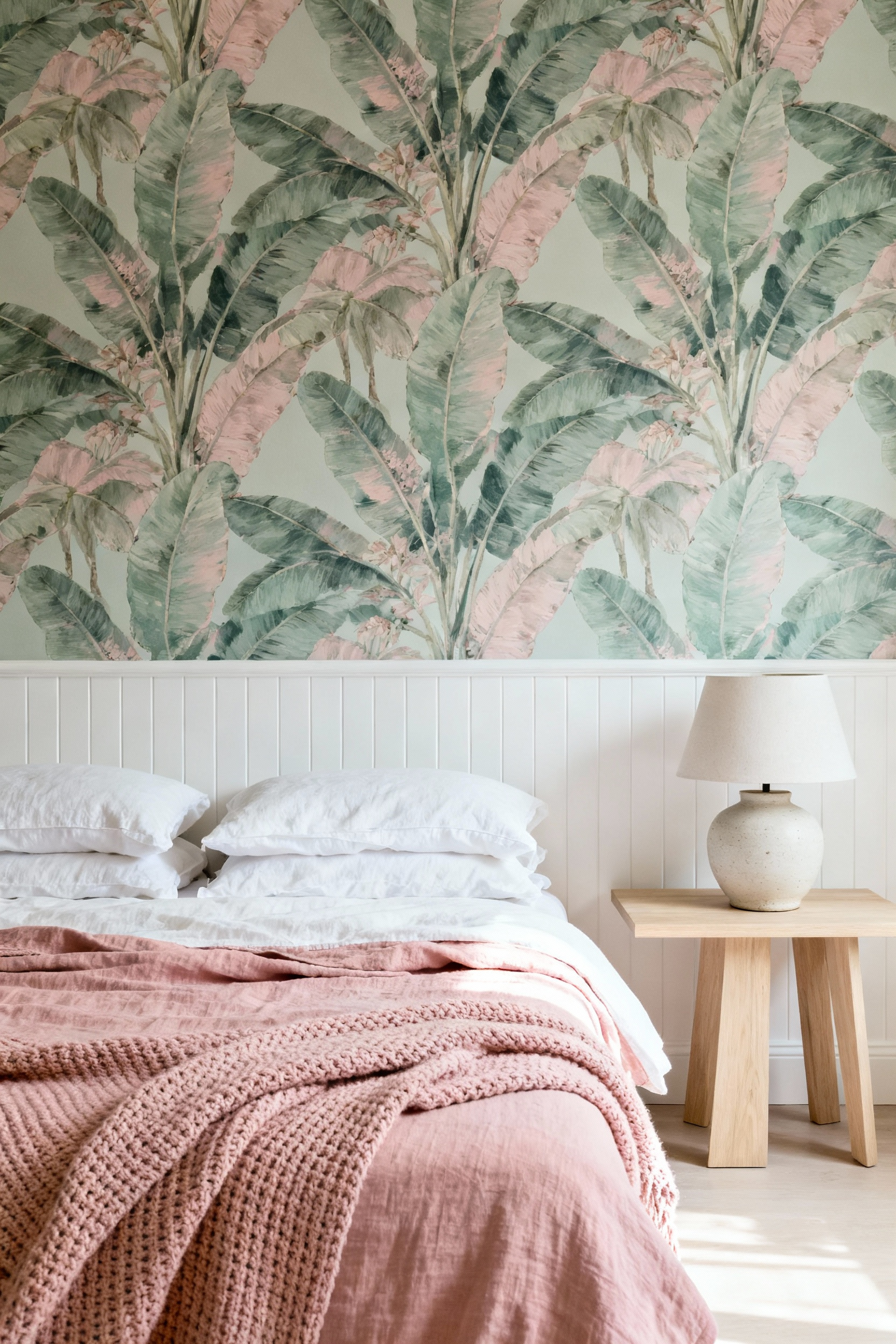
Next, focus on depth and specific furniture choices to create a sophisticated, inviting environment. Avoid generic sets and instead select statement pieces that spark interest, such as a bold-colored bed frame or a non-traditional chair with a unique shape. Soften these harder lines by layering textiles. Introduce an oversized area rug, heavy curtains, and a variety of patterned throw pillows in her “personal calm color.” These elements provide physical comfort while visually knitting the room together.
Finally, make the space feel unapologetically hers by curating art that tells a story. Large-scale visuals bridge the gap between furniture and small accessories:
- Design a cohesive gallery wall that reflects her current interests, such as fantasy novels or travel.
- Hang a single, large art piece to serve as a dramatic focal point.
- Display collections on a prominent scale rather than hiding them in drawers.
By prioritizing these larger expressive items now, you build a rich narrative framework that makes the final accessorizing stage effortless.
4. The Power of Peel-and-Stick Wallpaper for Risk-Free Drama
Girls’ tastes evolve rapidly as they transition from toddlers to teens, making permanent design choices risky. Peel-and-stick wallpaper offers the perfect solution for keeping up with these changes without long-term commitment. This material peels off cleanly without damaging paint or drywall, which makes it an ideal choice for renters or parents who want to experiment with bold trends. You can embrace frequent updates and style shifts knowing the underlying structure remains safe.
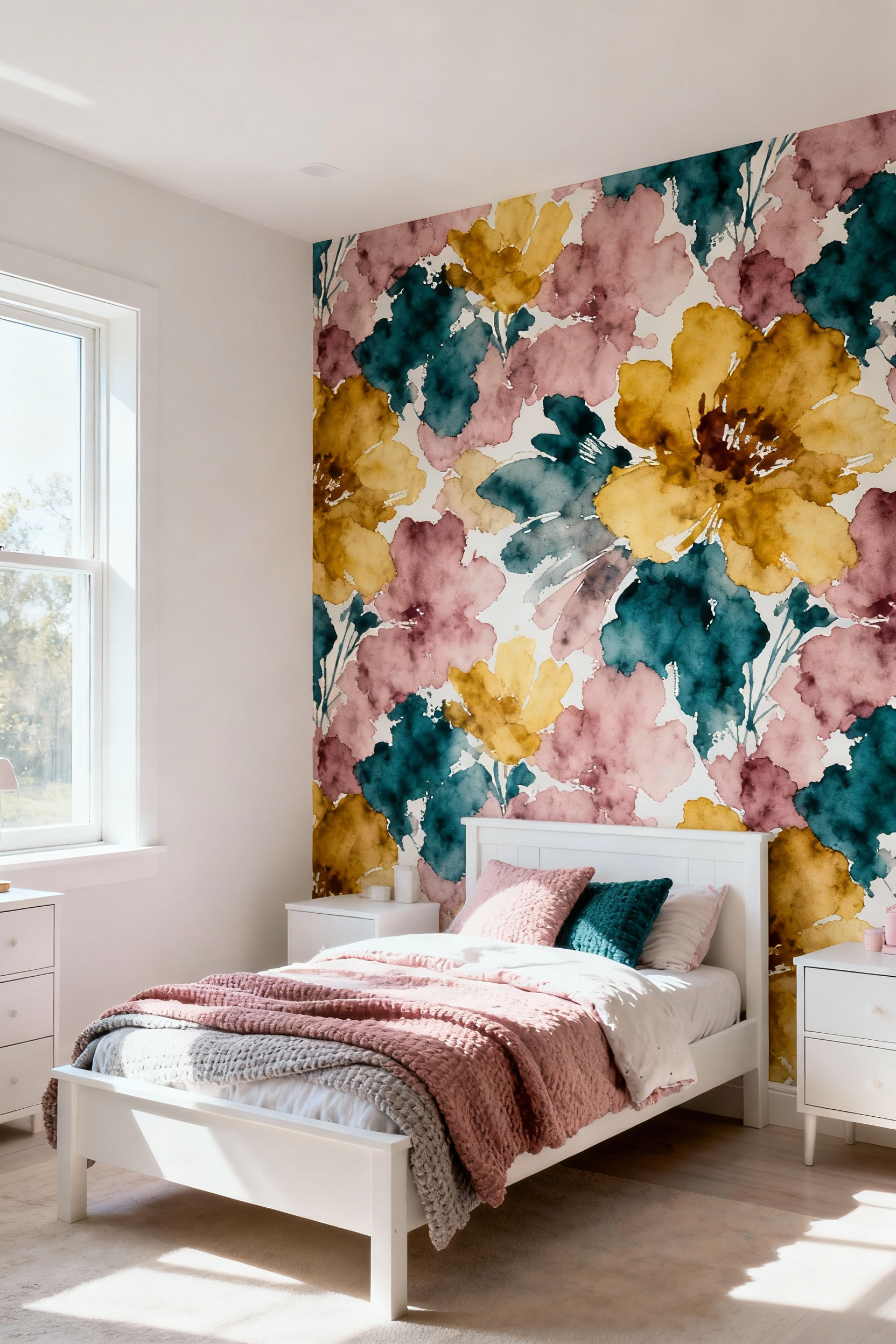
To maximize impact with minimal material, create a focal point by treating a single accent wall, typically the one behind the bed. Select dramatic prints like oversized watercolor florals, whimsical patterns, or bold geometrics to immediately anchor the room’s design. To mitigate the risk of outgrowing a theme too quickly, opt for designs with longevity. Neutral color palettes, timeless botanical prints, or abstract patterns often transition well through different life stages and can frequently be customized to match existing decor.
However, the “risk-free” promise of removable wallpaper relies entirely on proper surface preparation. Ensure the wall is completely smooth and wiped clean of dust before installation. Adhesives often fail on heavily textured walls, and bumps or imperfections will show through the paper. By starting with a pristine base, you ensure the wallpaper adheres correctly and removes easily when it is time for the next transformation.
5. Curating a Dynamic Gallery Wall: Art That Grows Up
A static gallery wall often becomes outdated quickly in a child’s room, so the design must prioritize flexibility over permanence. Instead of committing to fixed nail holes for a rigid grid, install picture ledges or floating shelves. This infrastructure allows you to layer frames and swap items instantly without requiring tools. When you do hang specific pieces, adopt an organic, asymmetrical layout with intentional negative space. This non-linear approach allows you to add new frames over time without forcing you to re-measure and re-hang the entire collection, ensuring the display expands naturally as she grows.
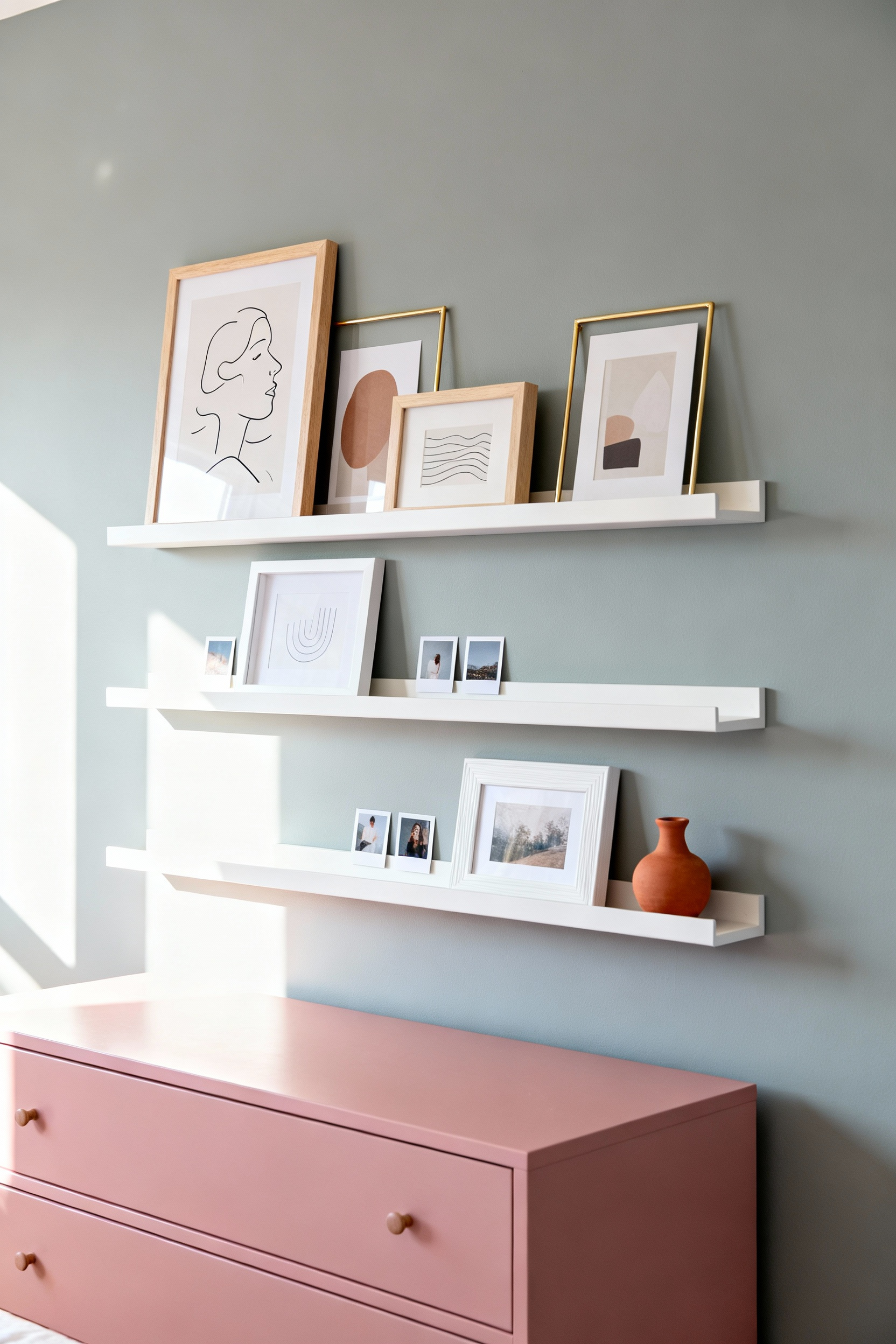
To make the space feel personal, actively incorporate her own creative projects as the anchors of the display. Frame her drawings, paintings, or school awards alongside store-bought prints to elevate them to gallery-worthy status. This turns the wall into a tangible record of her milestones. For high-rotation items, such as current sketches or instant photos, utilize simple clip or wire systems. These allow her to curate her own favorites weekly without damaging the walls or the artwork.
While the content of the wall should remain eclectic and evolving, the presentation requires a unifying element to prevent visual chaos. Apply a consistent framing strategy to keep the look polished:
- Uniform Frames: Select a single finish, such as all-white or natural wood, to create a cohesive boundary for every piece.
- Consistent Matting: Apply crisp white mats to every image, regardless of the frame style, to provide a clean, curated backdrop.
This approach ensures that even as colors and subjects change, the overall aesthetic remains intentional and stylish.
6. Lighting Schemes: Transitioning from Nightlights to Task Lamps
Transitioning a room from a nursery to a functional youth space requires a fundamental shift in lighting strategy. Reliance on a single nightlight must evolve into a layered scheme that accommodates complex needs like studying, reading, and relaxing. To achieve this, implement a combination of three distinct lighting types: ambient lighting, such as a central chandelier or modern pendant for general visibility; task lighting for specific activities; and accent lighting to introduce personality. This multi-source approach ensures the space remains adaptable, supporting the room’s function at every time of day.

Prioritize functional task lighting to prevent eye strain during homework or artistic projects. Select an adjustable-arm desk lamp or a clip-on bedside fixture that directs bright, focused illumination exactly where it is required. To maximize functionality in a single footprint, choose models equipped with built-in USB ports or wireless charging pads. Enhance these fixtures by installing smart bulbs or dimmers. This technology allows the user to adjust the color temperature: cooler, brighter tones improve concentration during study time, while warmer, softer hues create a calming atmosphere for winding down.
Finally, redefine the role of the traditional nightlight to suit an older child. Instead of a standard plug-in unit, use decorative accent lighting, such as LED strips installed behind a headboard or along shelving, to provide a soothing glow that doubles as a style feature. For purely practical purposes, utilize motion-sensor lights placed under the bed or inside the closet. This placement ensures safety during late-night movement without cluttering the visual design or disrupting the sleep environment with constant light.
7. Creating a Shape-Shifting Reading Nook
A shape-shifting reading nook maximizes utility in a girl’s bedroom by adapting to her changing needs without requiring major renovation. Start by looking for underutilized architectural features, such as a closet, wardrobe, or the space beneath a loft bed. Repurposing a built-in cupboard creates a dedicated retreat without sacrificing floor space. You should maintain original infrastructure, such as a clothes rail, to ensure you can easily convert the area back into a wardrobe later. To distinguish this zone from the rest of the room, install non-permanent elements like sheer curtains or a canopy. These affordable additions define the space for quiet privacy but remain easy to remove as the room matures.

Select furniture that supports flexibility rather than permanence. Avoid heavy, fixed armchairs in favor of versatile options like beanbags, floor cushions, or an oversized daybed. Beanbags are particularly effective because they allow a child to rearrange her environment independently. She can sculpt “custom furniture” for solo reading, lounging, or group playdates. This adaptability allows the physical layout of the nook to shift instantly based on the activity, keeping the room functional for both relaxation and high-energy fun.
Effective storage ensures the nook remains tidy regardless of its current configuration. Prioritize integrated solutions that serve multiple purposes, such as a built-in banquette with under-seat compartments or moveable crates that slide away quickly. Wall-mounted floating shelves are also a smart investment; they utilize vertical space and turn book covers into colorful, rotating decor. Mount these shelves high enough to accommodate future growth, ensuring the storage system remains practical from the early years through adolescence.
8. The Dual-Purpose Vanity and Desk Station
A dual-purpose vanity and desk station offers a seamless blend of utility and glamour, making it a highly practical solution for smaller bedrooms. To successfully execute this hybrid design, prioritize a desk with hidden storage, such as a flip-top lid or designated drawers. This feature allows makeup, brushes, and toiletries to be tucked away instantly, converting the surface from a beauty station into a distraction-free study zone. Pair this furniture piece with a chair that balances ergonomics with style. A tufted velvet or faux fur chair provides the physical support needed for homework sessions while enhancing the chic aesthetic of the vanity area.
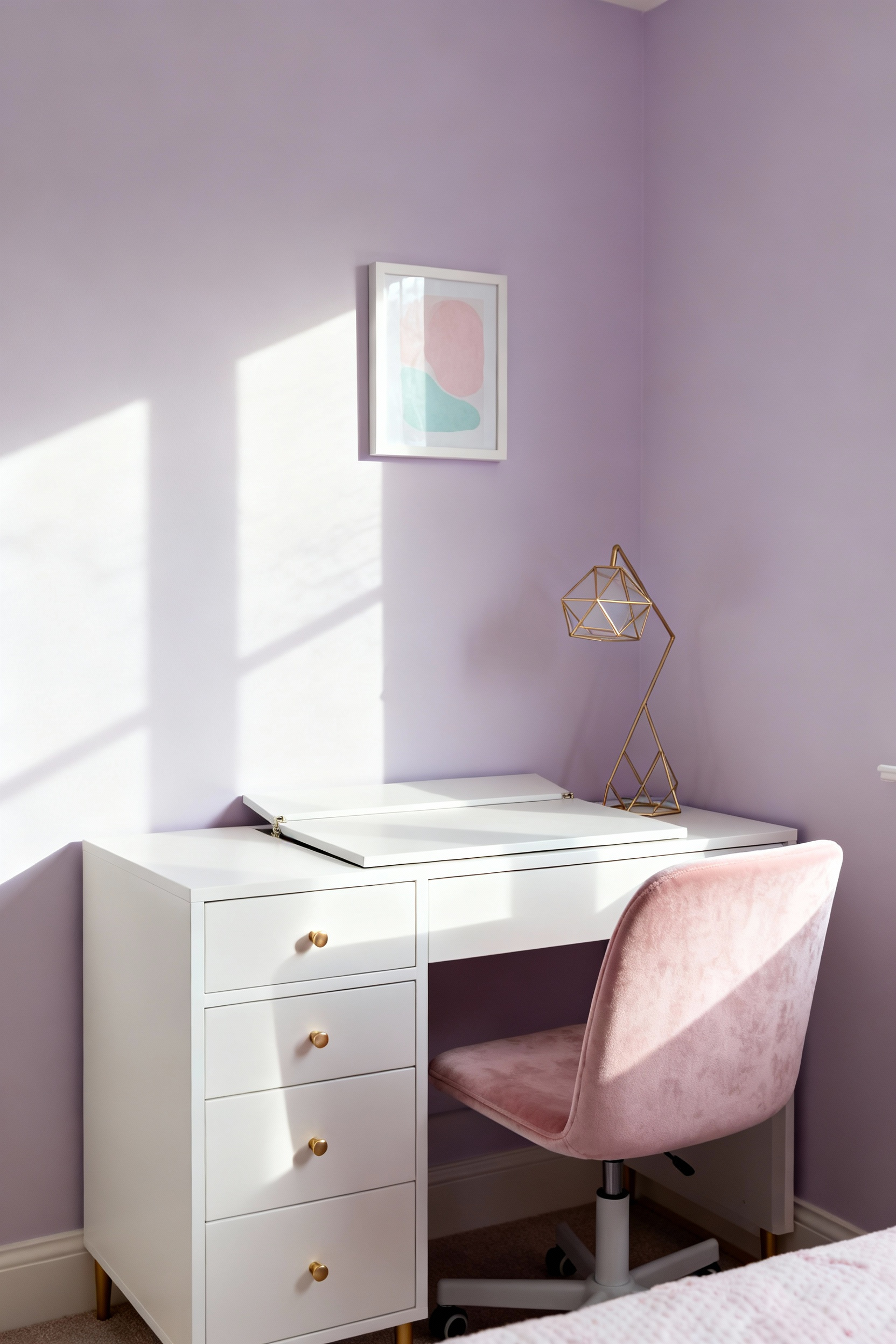
Lighting requirements differ significantly between applying makeup and reading textbooks, so adaptable fixtures are essential. Consider a mirror with built-in LED lights that can stand on the desktop for vanity use and easily slide aside when it is time to work. Alternatively, a wall-mounted swing-arm lamp offers the flexibility to adjust the angle for either task without cluttering the surface. To protect the desktop during these transitions, lay down a clear acrylic mat or a decorative vinyl protector. This prevents permanent stains from cosmetic spills and ensures the workspace remains pristine for academic use.
Finally, maximize the limited footprint by utilizing vertical space to keep the primary surface clear. Since the desk serves two distinct functions, permanent clutter on the desktop creates disorganization. Install floating shelves or a hutch above the station to house books, decor, and vanity organizers. This architectural approach keeps essential items within reach but off the workspace, allowing the room to adapt effortlessly to the changing demands of the school year and social calendar.
Phase 3: Seasonal Mastery – Keeping the Room Fresh Year-Round
Establishing a timeless foundation is key to seasonal adaptability. Start with a neutral wall color, such as soft white or warm gray. This versatile backdrop allows you to overhaul the room’s design simply by changing accessories rather than committing to a labor-intensive paint job. Once the walls are set, master the art of swappable bedding. Invest in a high-quality neutral duvet to serve as a permanent base. You can then introduce seasonal textures without creating bulky storage issues. Layer featherweight linen throws during warmer months, then switch to thick knits or faux fur accents as winter approaches.

To keep the visual interest high, implement a system for rotating decor. Utilize floating shelves or a flexible gallery wall to display prints and small objects that reflect the current season or evolving interests. This approach injects new color palettes instantly, such as floral prints for spring or warmer earth tones for autumn, without permanent commitment. Finish the look by incorporating living greenery. Add a low-maintenance houseplant or a vase of seasonal flowers to the bedside table. This simple addition brings a natural element indoors and ensures the space feels vibrant and fresh regardless of the time of year.
9. Spring Refresh: Introducing Botanical Textiles and Light Florals
Transform the bedroom atmosphere instantly by prioritizing the bed as the primary focal point. Swap out heavy winter linens for light, crisp white sheets that promote airflow. Layer on a duvet or comforter featuring a vibrant, modern floral or leafy print to serve as a seasonal centerpiece. To maintain visual balance and avoid pattern overload, coordinate this main textile with simpler accents. Add throw pillows or a lightweight blanket in solid, complementary spring colors like sage green or soft pink. This approach refreshes the space immediately without requiring a complete redesign.

Build a light and airy foundation to maximize the feeling of renewal. Start with a base of earthy whites, ivories, or muted beiges to keep the room bright. Against this neutral backdrop, introduce a delicate floral theme through accessories like breathable curtains or a blush vintage-style rug. Incorporate accents in natural hues, such as mint greens and soothing pastels like lilac or dusty pink. These colors mimic the outdoors and create a calming, cohesive environment that feels curated rather than cluttered.
Finish the look with low-commitment design elements that offer high impact. Apply a peel-and-stick botanical wallpaper to the accent wall behind the bed, or frame an oversized piece of floral fabric as unique wall art. These temporary solutions allow for dramatic changes without permanent commitment. Ground the aesthetic by introducing natural materials like rattan, bamboo, or wood furniture. Finally, place a low-maintenance plant, such as a snake plant or peace lily, on a shelf or nightstand to complete the botanical oasis.
10. Summer Breezes: Swapping Heavy Drapes for Sheer Treatments
Swapping heavy drapes for sheer treatments instantly transforms a girl’s bedroom for the summer season. Replacing dense fabrics with lightweight materials like cotton, linen, or voile allows air to circulate visually and creates a dreamy, airy atmosphere. As the fabric gently moves with the breeze, it adds a graceful touch to the decor. Beyond aesthetics, sheer fabrics serve a practical function by diffusing harsh UV rays. This filtration protects furniture, paint, and carpeting from sun damage while still permitting natural light to wash the room in a soft, warm glow.

While sheers invite sunlight indoors, they often become transparent at night when interior lights are on. To maintain privacy and ensure a restful sleep environment, layer sheer curtains with a functional secondary treatment. Simple roller blinds or decorative blackout panels work effectively behind the sheer layer to control light levels. This combination offers a versatile solution: a soft, ethereal look during the day and complete darkness and privacy in the evening.
This switch also provides a budget-friendly opportunity to refresh the room’s style. Since sheer curtains are typically more affordable than heavy custom drapes, you can embrace seasonal trends without a significant investment. Consider options featuring pastel colors, soft florals, or whimsical themes like stars to match the room’s personality. Alternatively, choose neutral tones like white or cream to create a versatile backdrop for colorful summer accessories. Most sheer options are machine-washable, making them a practical, low-maintenance choice for a quick seasonal update.
11. Autumnal Texture: Layering Chunky Knits and Warmer Tones
Transitioning a bedroom for autumn begins with a deliberate shift in the color palette. Move beyond standard pinks and purples by introducing warm, earthy jewel tones through accent pieces. Shades like mustard yellow, burnt orange, deep burgundy, and forest green instantly change the room’s atmosphere without requiring new paint. Apply these colors to easily swappable items, such as throw pillows or a statement bedside vase, to effectively warm the visual temperature of the space.
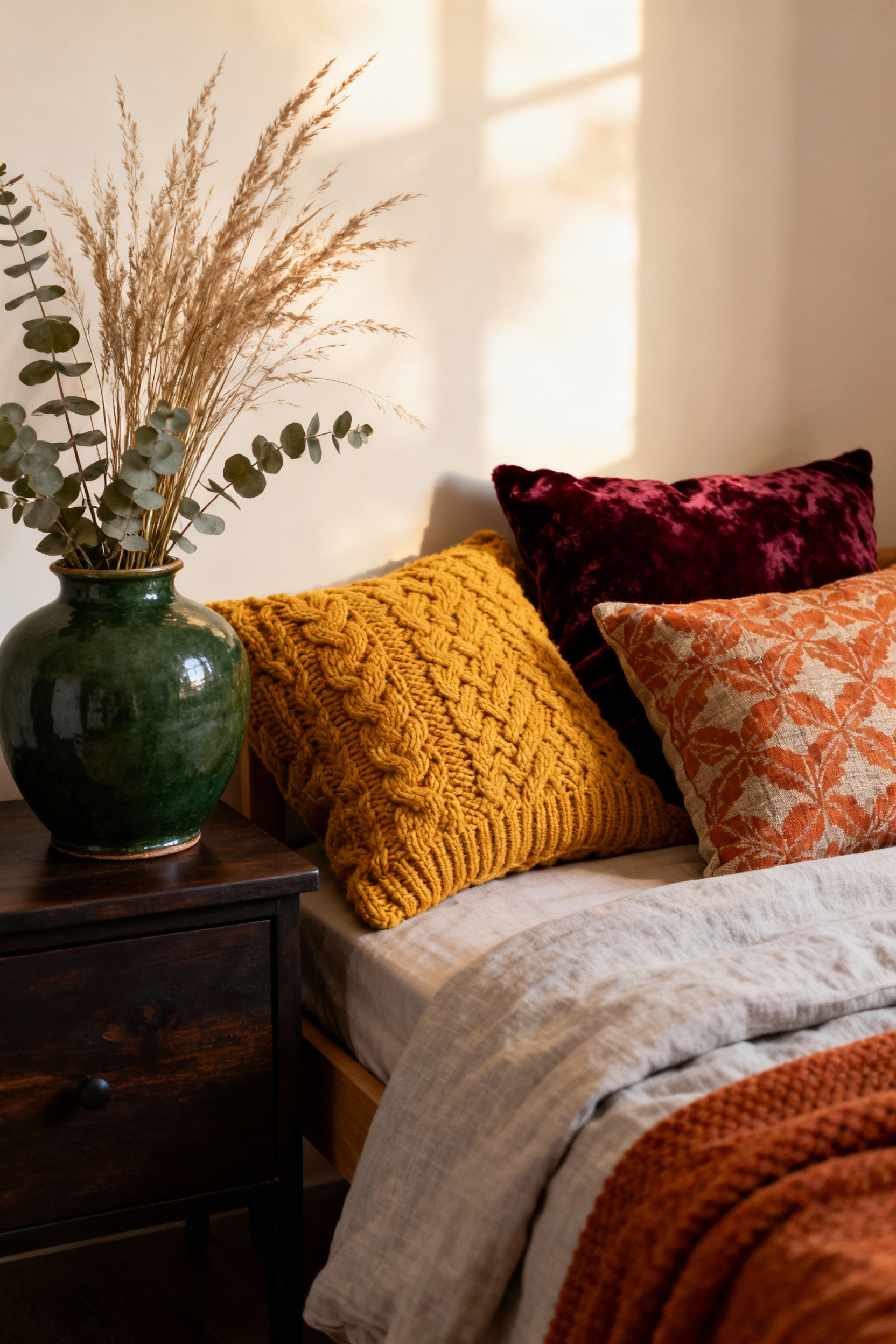
Texture plays the most crucial role in creating a cozy, seasonal environment. The most impactful addition is a super-sized, chunky knit throw draped casually over a reading chair or the foot of the bed. Select chenille or cable-knit materials in neutral creams or deep olives to maximize tactile interest. For a luxe, professional finish, mix contrasting fabrics to create depth. Layer the rougher, thick weave of the knit against smoother surfaces, such as a velvet duvet cover or plush faux fur pillows.
Finalize the seasonal update by grounding the look with natural materials and specific lighting. Incorporate wooden elements, like a rustic nightstand or a decorative wood tray, to reinforce the earthy aesthetic established by your textiles. Lighting should enhance, not overpower, these rich layers. Switch to soft yellow bulbs or install warm string lights to cast an intimate glow over the room, highlighting the interplay between the chunky knits and smoother fabrics.
12. Winter Coziness: Faux Fur Throws and Fairy Light Canopies
Create a magical retreat by transforming the bed into a glowing focal point. Instead of standard string lights, install curtain fairy lights behind a sheer, flowy canopy suspended from the ceiling. This arrangement creates a dense cascade of illumination that mimics a wall of stars, instantly establishing a “fairyland” atmosphere. Opt for warm white or soft pink LED bulbs to ensure the ambiance remains inviting and golden, avoiding the harshness of cool white tones during the winter months.
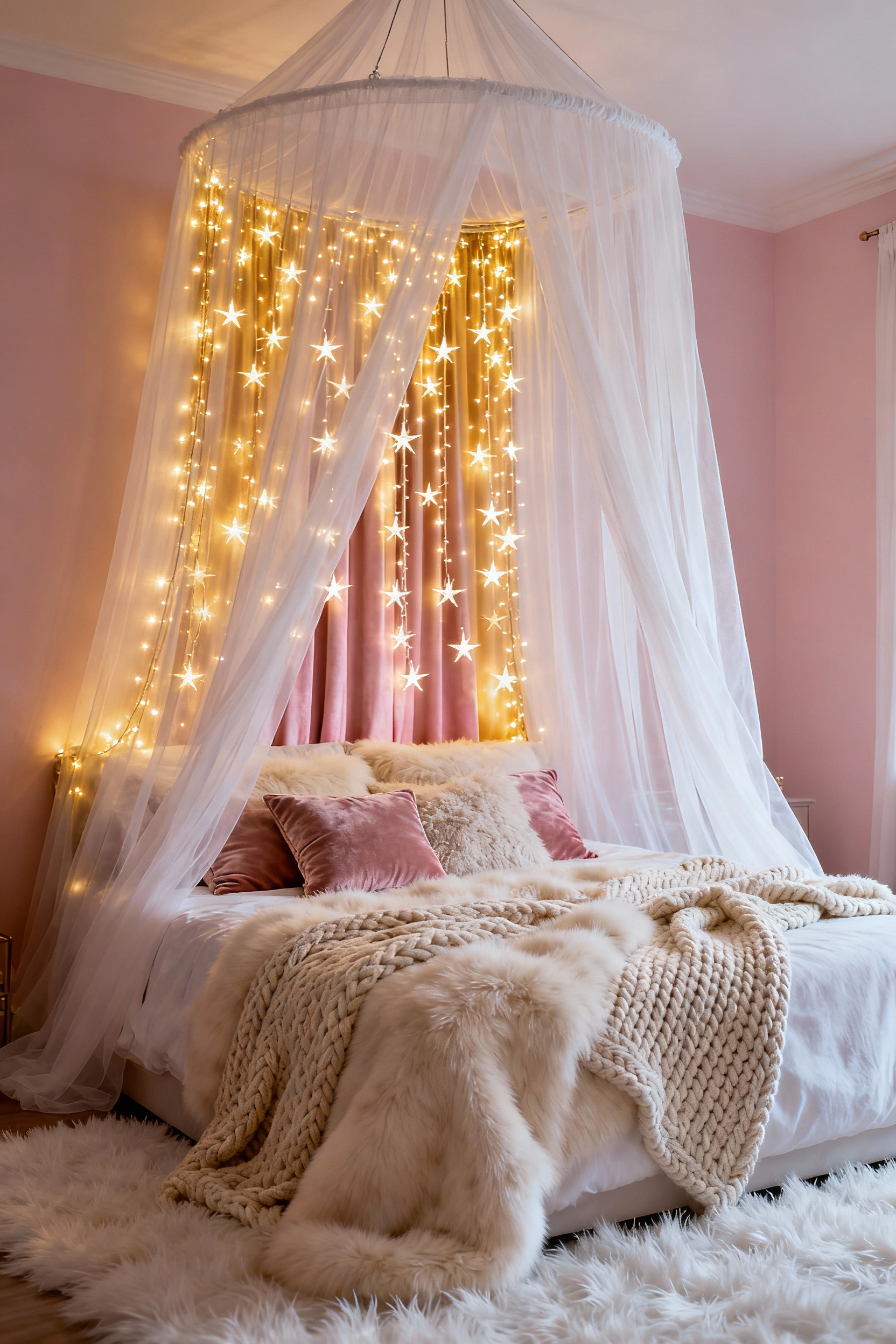
Introduce warmth and sophistication through strategic textile layering. Drape a single, high-quality faux fur throw diagonally across the foot of the bed or casually over a statement chair. Limit this texture to one major piece to provide a touch of luxury without cluttering the space. To elevate the look, pair the fur with contrasting bedding materials, such as cable-knit cotton or smooth velvet pillows. Stick to soft neutrals like cream, light gray, or blush to keep the design bright and elegant.
For a final touch of whimsy, weave a lightweight faux flower or ivy garland through the upper portion of the canopy and lights. This simple addition reinforces a nature-inspired “winter fairy” aesthetic, blending the organic textures with the soft illumination. These elements work together to create a cozy, adaptable space that feels enchanting all season long.
13. The ‘Holiday Magic’ Layer: Adding a Bedroom Mini-Tree
Transforming a bedroom for the holidays starts with the right focal point. A mini-tree, ranging from one to four feet tall, brings immediate festive cheer without overwhelming the floor plan. Place the tree on a dresser, nightstand, or sturdy shelf to maximize impact in a small footprint. This elevation also keeps delicate decorations out of reach of pets or toddlers. For safety and visual cleanliness, prioritize battery-operated lights to eliminate tripping hazards from trailing cords. If styling for younger girls, opt exclusively for shatterproof ornaments to ensure the setup remains safe and durable.

To achieve a designer look, maintain a cohesive palette that complements the room’s existing decor. A small tree requires a simplified approach to avoid looking cluttered. Instead of overcrowding the branches with small baubles, focus on high-impact textures that match the room’s accent colors, such as pink, silver, or gold. Consider using these elements for a polished finish:
- Velvet bows or ribbon trails to add softness and volume without bulk.
- Felt ball garlands to introduce color and whimsy.
- Faux berries to provide a natural pop of contrast.
Beyond aesthetics, this addition serves a functional purpose as a comforting seasonal nightlight. Position the tree to cast a warm, magical glow near the bed. This soft lighting creates a cozy atmosphere that makes bedtime an exciting, festive routine rather than a chore. Involve the child in the design process by letting her select a theme, such as a pastel winter wonderland or a teal and gold scheme. Her participation in picking colors or crafting simple ornaments increases her sense of ownership and makes the space feel truly special.
Phase 4: Lifestyle Integration – The Expert Approach
Prioritize a “grow-with-her” design strategy to ensure the room remains relevant for years. Start with a timeless foundation centered on adult-sized, quality furniture, such as a statement bed or dresser, paired with a sophisticated neutral palette. This approach allows you to use accessories, paint, and removable wall art to capture current trends or specific interests. As she transitions from child to tween and teen, you can update the room’s aesthetic through simple, budget-friendly swaps rather than requiring a complete structural overhaul.

Because a modern girl’s room serves as a hub for her entire life, you must move beyond sleeping arrangements and create functional zones for key activities. A lifestyle-integrated layout supports studying, hobbies, and socializing through designated areas:
- Study and Vanity Nook: Incorporate a chic desk that doubles as a vanity, ensuring it is equipped with proper lighting for both focused homework and getting ready.
- Relaxation Corner: Define a specific area for downtime using a hanging chair, beanbag, or cozy reading nook to encourage relaxation separate from the bed.
Finally, transform the space into a personalized sanctuary through active collaboration. Involve her in the design process to ensure the room reflects her unique personality and memories. Curate a gallery wall for cherished photos or family travel mementos, and layer in her favorite textures, such as fluffy pillows or faux fur throws. You might even allow her to select non-permanent finishes or specific accent colors. This involvement guarantees she feels a true sense of ownership over her environment.
14. The ‘Birthday Week’ Transformation Kit
Transforming a bedroom for a “Birthday Week” requires a balance of high-impact visuals and low-commitment installation. The goal is to create a celebratory atmosphere that lasts longer than a single day but leaves no permanent mark on the room. Start by focusing on the bed, turning it into a personalized “throne.” Swap out everyday linens for a set of bright, patterned specialty bedding reserved specifically for this occasion. To further distinguish the space, suspend a simple bed canopy, such as sheer tulle or a macrame hanging, to create an immediate focal point that elevates the entire room.
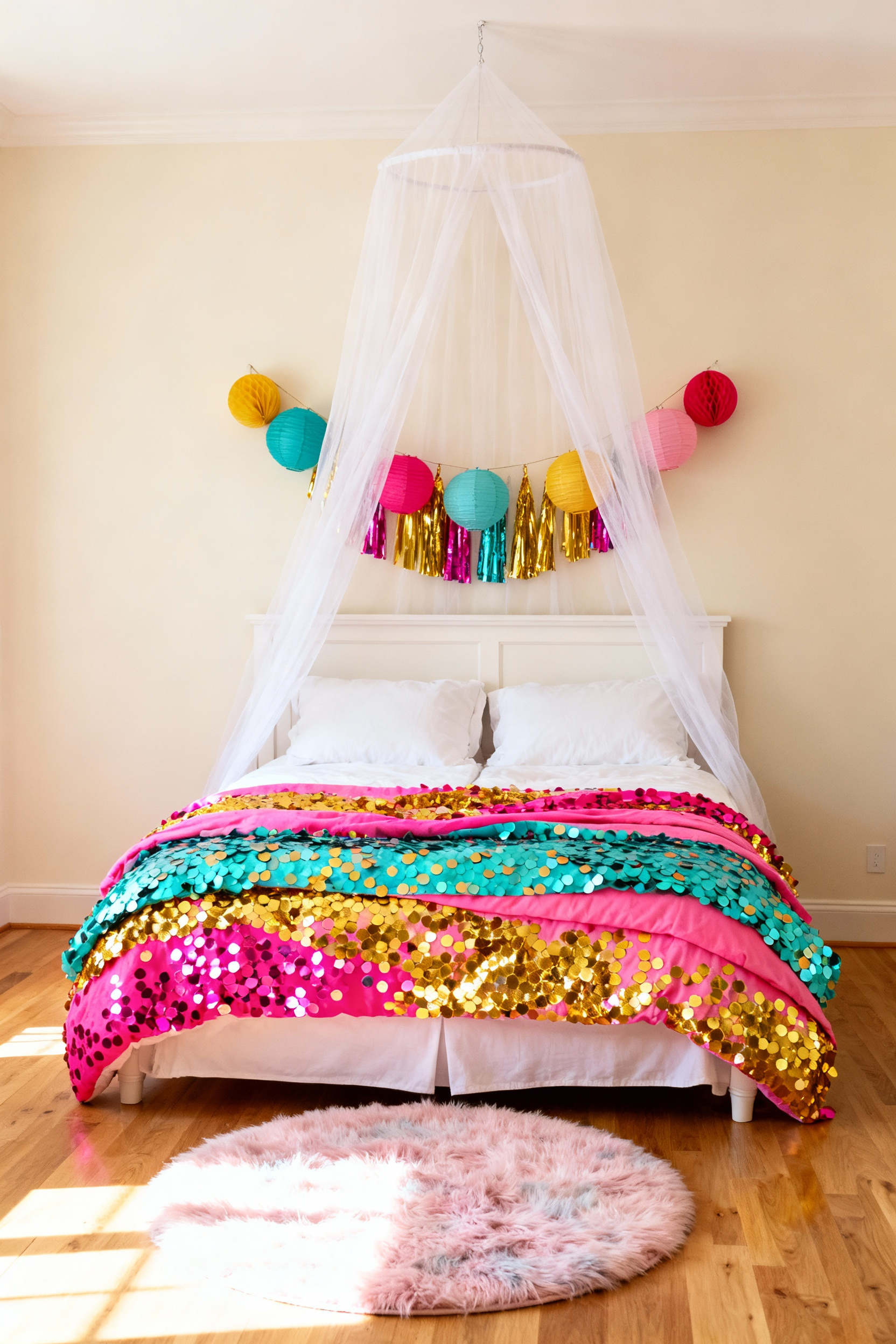
Lighting and wall decor play pivotal roles in establishing a festive mood. Prioritize temporary wall accents that offer significant visual change, such as peel-and-stick decals in shapes like stars or polka dots. These adhere securely but remove easily when the week concludes. Alternatively, drape themed garlands featuring clouds or rainbows across the headboard or windows. Complement these visual elements with specialty lighting. LED light strips attached to a desk or bed frame add a modern touch, while fairy lights draped along the walls provide a cozy, magical glow that enhances the ambiance each night.
Finally, integrate an interactive element to make the décor an experience rather than just a backdrop. Include materials for a simple DIY project within the kit, such as a small canvas for painting or supplies to decorate a picture frame. This activity allows the birthday girl to actively participate in the transformation of her space. Once completed, this new piece of personalized art can be displayed immediately, serving as a tangible memory of the celebration.
15. The Art of the ‘Shop Your Home’ Swap for Budget Updates
Refreshing a girl’s bedroom does not require a credit card; it simply requires a new perspective on your existing inventory. Walk through other rooms to identify underutilized textiles and lighting. You can transform a standard twin bed into a chic daybed by borrowing a textured coverlet or unique throw blanket from the living room. Pile on throw pillows swapped from a downstairs sofa to create a cozy lounging nook. Even moving a table lamp from a guest room can instantly shift the room’s ambiance and color scheme without cost.
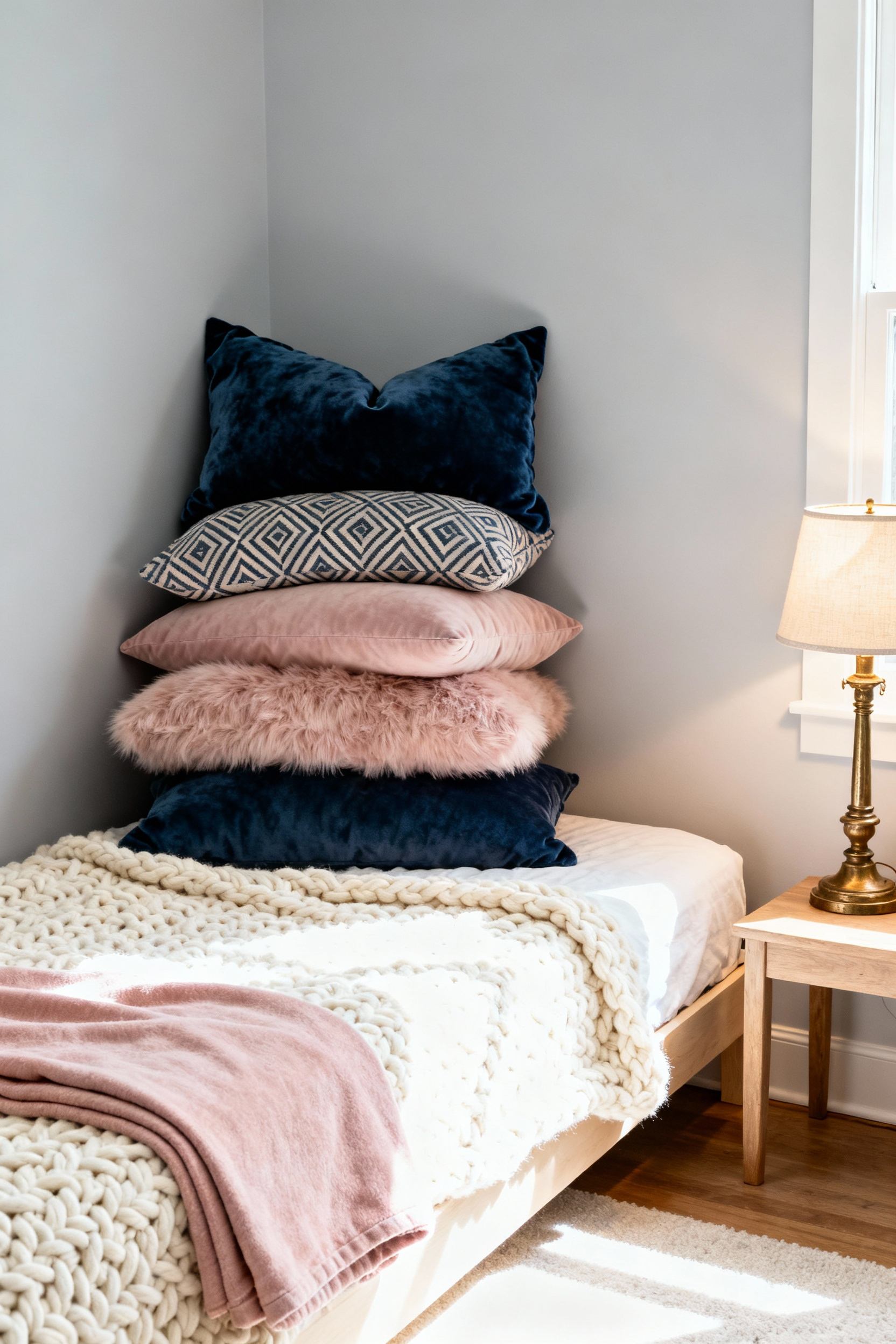
Creative storage solutions often hide in plain sight within common areas. Relocate a cubby organizer, such as a 3×3 unit from a playroom or basement, into the bedroom closet to serve as a repurposed dresser for folded clothes. For the vanity or dresser top, raid the kitchen cabinets. Decorative serving trays, bowls, or cake plates function perfectly as stylish catch-alls for jewelry, makeup brushes, and hair accessories. You can also elevate existing furniture by swapping standard drawer knobs for playful hardware found on other pieces or updated with a simple DIY finish.
Complete the transformation by refreshing the wall decor. Take down old artwork and replace it with personal photos housed in frames gathered from around the house. Mixing different frame sizes and styles allows you to create a curated, budget-friendly gallery wall. This simple rotation creates a high-impact visual update that makes the space feel personalized and brand new.
16. Zoning the Room for Sleep, Study, and Socializing
Effective bedroom design requires distinct zones for specific activities. A girl’s room serves as a multifunctional sanctuary, so separating the mental strain of homework from the restoration of sleep is vital. You must create three distinct moods—calm, focus, and fun—within a single footprint. To achieve this, use furniture to dictate the flow. In smaller spaces, embrace vertical zoning with a loft or cabin bed. This elevates the sleeping area and frees up floor space underneath for a study desk or social nook. For larger rooms, physically separate the bed from the workspace using a freestanding screen, a low bookcase, or decorative curtains on a ceiling track.
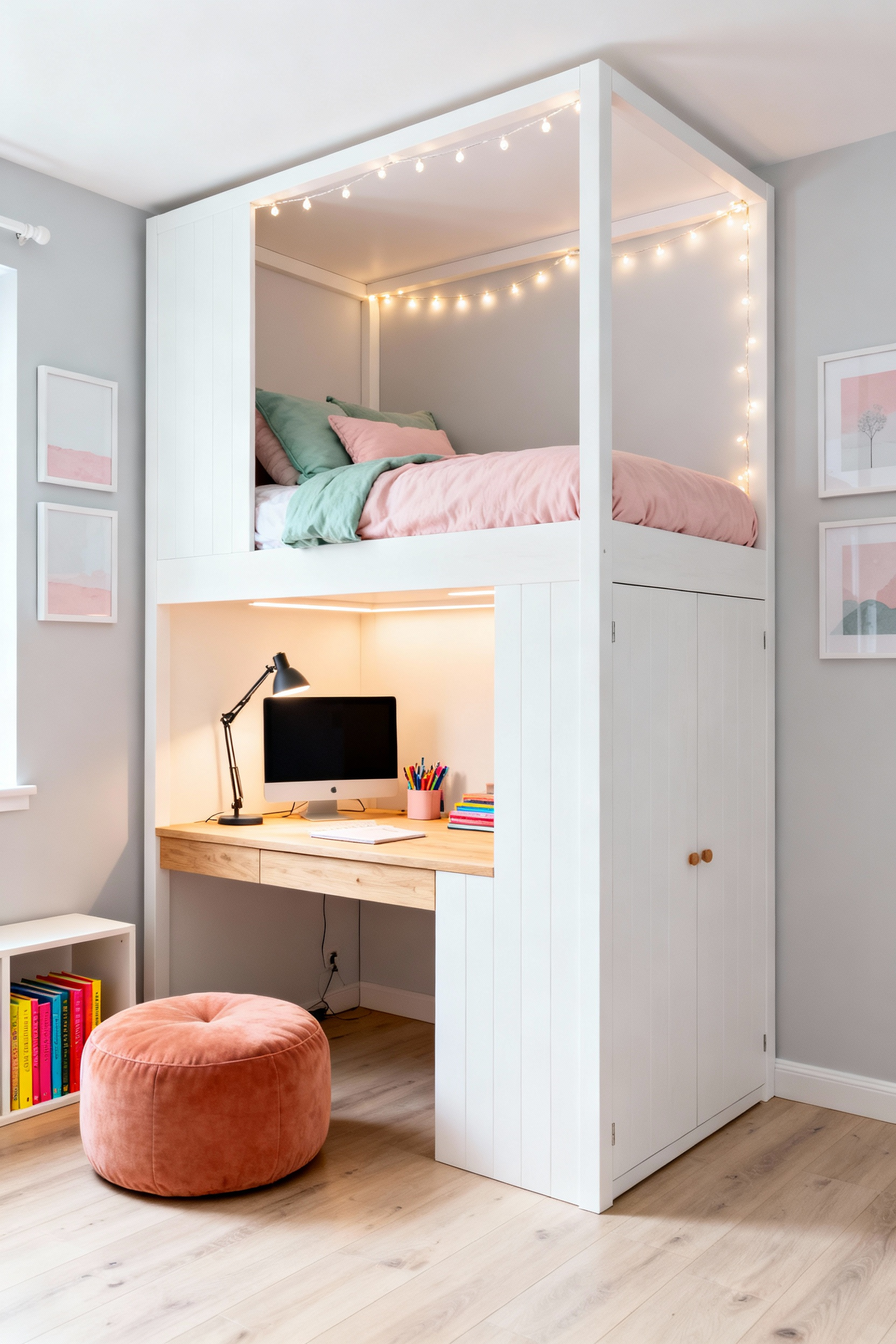
Visual cues define these areas without the need for permanent walls. Use area rugs to anchor specific spots, such as a plush rug for a social corner filled with bean bags or floor pillows. Lighting also plays a crucial role in shifting the atmosphere. Install bright task lighting at the desk for concentration, and switch to soft string lights or floor lamps in the lounging area to encourage relaxation. This approach creates a flexible space that adapts seamlessly to every part of the day.
To ensure each zone functions correctly, follow these placement strategies:
- Optimize the Study Zone: Position the desk near the greatest natural light source to boost productivity and use integrated storage to keep clutter away from the sleep area.
- Define the Social Nook: Section off a corner with flexible seating like floor pillows or an armchair that can be easily rearranged when friends visit.
- Protect the Sleep Zone: Ensure the bed feels secluded from the active zones to promote rest, using soft dividers or distance to create a clear boundary.
Conclusion: Celebrating Every Season of Childhood Through Design
Creating a bedroom that spans from toddlerhood to the teen years requires viewing the space as a dynamic backdrop rather than a static time capsule. By anchoring the room with a timeless neutral foundation and adaptable furniture, you allow the design to breathe and evolve alongside her developing personality. This approach shifts the focus from constant, costly renovations to thoughtful curation. Whether you are swapping out textiles for a trend-focused update or transitioning a play zone into a study hub, the goal remains the same: providing a sanctuary that honors who she is today while welcoming who she will become tomorrow.
Adopting this flexible mindset fosters a home environment that celebrates growth without sacrificing style or functionality. Establishing this sophisticated and adaptable approach to bedroom decor for girls empowers your daughter to take ownership of her environment, turning interior design into a tool for autonomy and self-expression. Begin by auditing the current space to identify one permanent investment piece to retain and one rigid “theme element” to replace with a versatile alternative. Establish this balance now, and you ensure her room remains a beloved, functional retreat through every season of her childhood.
Frequently Asked Questions
How do I ensure my girl’s bedroom decor remains relevant through her teenage years?
Focus on a timeless foundation. Invest in quality, adult-sized furniture (full or queen bed, neutral dresser) and keep wall colors neutral (soft white or gray). Personality should be introduced solely through easily replaceable elements like bedding, art prints, lamps, and temporary peel-and-stick wallpaper. This strategy maximizes longevity and minimizes future cost.
What are the best timeless color palettes for a girl’s room that aren’t overly pink?
Opt for sophisticated neutral bases like warm cream, sage green, soft lavender, light gray, or monochrome schemes (black and white). These palettes provide a calm, versatile backdrop. You can introduce pops of bright color or pastels via accessories, ensuring the room remains highly adaptable to changing tastes.
How can I maximize space and function in a small girl’s bedroom?
Utilize vertical space through loft or cabin beds to separate sleep and study zones. Invest in modular, multi-functional furniture, such as a desk that doubles as a vanity (dual-purpose) or storage benches. Prioritize high-quality floating shelves over floor-standing bookcases to maximize usable floor area.






